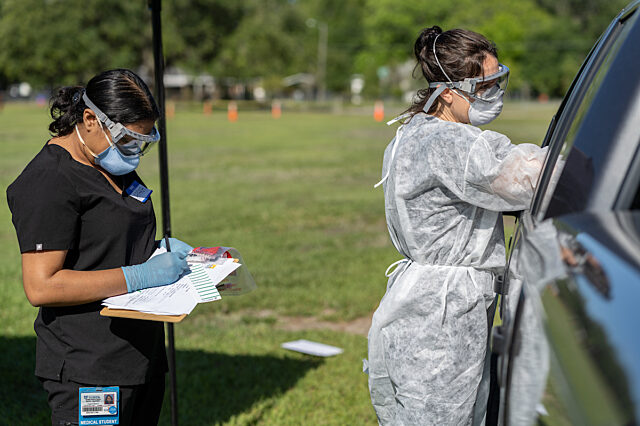UF Health students tackle community needs through COVID-19 Student Service Corps

Students from across UF Health have teamed up to assess and meet the needs of Gainesville’s citizens through the creation of a new organization, the UF chapter of the COVID-19 Student Service Corps.
Initially designed by students and faculty at Columbia University, the corps aims to support health systems, patients, the workforce and the communities facing the COVID-19 pandemic through facilitating interprofessional student service-learning projects.
The UF chapter is involved in 33 ongoing projects, which encompass areas including public health; COVID-19 testing; the production and distribution of personal protective equipment, such as face masks and face shields; and gratitude projects like the website 6FTCloser and the baking project Cookies on the Front Lines.
Fourth-year medical student Lauren Lautenslager serves as the class of 2021 co-chair in the corps’ oversight committee, where she acts as a liaison between the community and the student volunteers. She’s participated in UF Health COVID-19 testing efforts across Gainesville, babysat the children of two UF Health physicians, and participated in Zoom calls with members of other Student Service Corps at universities across the nation.
Lautenslager said joining the corps has allowed her to hone her skills in logistical organization, communication and teamwork during a time when many students can feel helpless.
“A lot of us go into medicine because we get innate satisfaction from pouring ourselves out into others,” she said. “Sometimes in medical school, you don’t see the big picture of how your efforts are benefiting others. Volunteering in the community is a humbling, rewarding reminder of why we’re doing what we’re doing. The service corps has given us a unique sense of purpose when the stay-at-home order makes us feel unable to contribute.”
Ellen Waidner, a second-year student in the College of Public Health and Health Professions’ Doctor of Physical Therapy program, serves on the oversight committee with Lautenslager. She said being in the corps with students from various health programs allows for a cross-pollination of perspectives that produces stronger health care practitioners.
“When we graduate, we will all see patients who require a multidisciplinary approach to care,” Waidner said. “This committee has allowed us to gain experience working with other professions while we’re still students, better preparing us for our future.”
Kim Dunleavy, P.T., Ph.D., an associate clinical professor and director of professional education and community engagement in the UF College of Public Health and Health Professions’ department of physical therapy, learned about Columbia University’s model for the corps at the Global Forum for Innovation in Health Professions Education, a component of the National Academies of Sciences, Engineering and Medicine. She brought the idea to UF faculty and now serves as a faculty co-chair for the UF corps. She helps the students work through challenges but allows them a certain amount of autonomy to learn and practice valuable skills for their future careers.
“For students doing COVID-19 testing, this is something they’re never going to forget. For students working to provide other nonmedical services to those without resources during this time, it gives them a perspective on the much broader problems we’re experiencing with this epidemic,” Dunleavy said. “It prepares students for not only their roles as health care providers but also sets them up to be better, more well-rounded clinicians who address their patients’ priorities and everything that impacts care, including the social determinants of health.”
Grant Harrell, M.D., an assistant professor in the UF College of Medicine’s department of community health and family medicine and a physician at UF Health Family Medicine – Old Town, serves with Dunleavy as a faculty co-chair for the corps. He says the decisions made and actions taken each day in the corps — such as helping with testing efforts, conducting Zoom chats with isolated people at nursing homes or sewing masks — prove that students have the ability to transform health outcomes in their communities.
“It’s valuable for students to learn they have the power to facilitate positive change,” Harrell said. “They don’t have to wait until they have an M.D. behind their names to help in a public health crisis.”